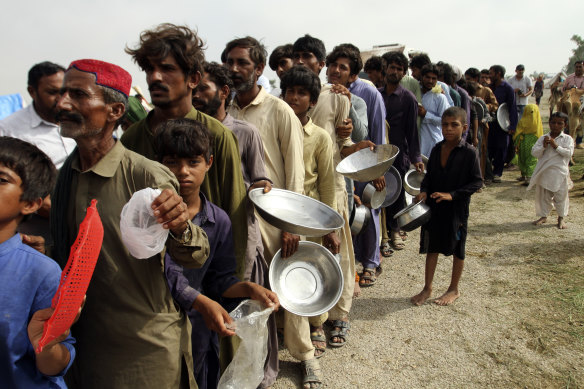
You had to dig deep into the United Nations Environment Programme’s report on climate change this week to find fragments of good news. There was a “glimmer of hope” that some countries had strengthened their climate targets, the report said, and “some progress” had been made in slowing the growth in emissions. But they were slim pickings.
The rest is pretty depressing. Emissions, which need to fall sooner rather than later, have grown 10.6 per cent since the last report. The only positive is a slight slowing in the rate of increase on the previous year, hardly cause for celebration. And while it is good that 26 countries – previous laggard Australia among them – have recently honoured their pledge to improve their climate targets, 167 countries have not, despite agreeing to do so at last year’s Glasgow summit.
Flood-affected people queue with utensils to get food, distributed by Pakistani troops in Rajanpur.Credit:AP
If we continue on this path, the report says, the planet will warm by up to 2.9 degrees by the end of the century. This would probably result in a global weather system that scientists say will make events such as the recent flooding in Victoria, the record-breaking drought in Europe, the humanitarian crisis in Pakistan and hurricanes in the United States increasingly common. There is “no credible pathway”, it says, to hitting the goal of a 1.5 degree temperature rise set at the Paris Accords in 2015. The bottom line, in the words of Simon Stiell, executive secretary of UN Climate Change, is that what we’re doing is “nowhere near the scale and pace of emission reductions required”.
We can only hope that this year of calamities has hardened the wealthier nations’ resolve to act, ahead of next month’s COP27 UN climate conference in Egypt, recognising that climate change is no longer an exotic theory that might bite us in the distant future, or affect some unfortunate people far away, but a phenomenon that is now impacting on livelihoods and economies globally.
It’s not all gloom and doom. US President Joe Biden’s Inflation Reduction Act committed $US369 billion towards climate and energy provisions. China appears to be acting on its pledge to stop building new coal-fired power stations overseas and instead to be increasing its support for low-carbon solutions. Encouragingly, while most of the world’s power still comes from fossil fuels, the growth in new power production is overwhelmingly in renewables, according to data from the International Renewable Energy Agency.
As David Wallace-Wells wrote in the New York Times this week, it was not that long ago that scientists were predicting a temperature rise of five degrees, triggering “civilisational collapse”. That no longer seems likely. Instead, he writes: “We are getting a clearer sense of what’s to come: a new world, full of disruption but also billions of people, well past climate normal and yet mercifully short of true climate apocalypse.”
In Australia, after decades of internal bickering, climate denial and a sense of powerlessness, we are now endeavouring to solve the problem rather than standing on the sidelines. Opposition Leader Peter Dutton appears to have accepted the need to cut emissions (and is interested in nuclear power to do so), though members of his party still remain suspicious of climate science.
Most Australians, according to Lowy Institute polling, believe we should take steps now to counter global warming “even if this involves significant costs”. This year, for the first time, electricity from solar, much of it generated by home owners’ rooftop panels, briefly exceeded that from fossil fuels. Australia has belatedly improved its emissions pledge to the United Nations. And with the passing into law last month of its Climate Change Act, the Albanese government ended a decade and a half of inaction and committed us to an emissions reduction of 43 per cent by 2030, and to hit net zero by 2050.
This week, the government took the first steps to reaching those targets with a budget that included short-term measures and a road map into the next decade.
That includes a multibillion-dollar scheme to overhaul the national grid to accommodate renewable energy, incentives for electric cars, funding for 400 community batteries for remote and regional areas, and $102 million to fund solar panels for 25,000 apartment residents and low-income households.
Also encouraging is increased funding for the Great Barrier Reef, the Disaster Ready Fund to fight the inevitable effects of climate change, and $225 million over four years to implement the Threatened Species Action Plan. Critics may argue it did not go far enough, but it is at least a nudge in the right direction.
Australia is certainly better placed than most to transition from an economy powered by fossil fuels to one reliant on sun, wind and hydro. It is possible. But be in no doubt: ahead lies a bulk of work that will probably be expensive, socially disruptive and reliant on yet-to-be-developed technologies.
Coal, suddenly socially unacceptable, can’t just be turned off overnight. We will probably have to depend on gas, as expensive as it is, during the transition period. And Dutton is right: we should at least consider small nuclear reactors in the unlikely event that they stack up. Electric cars, clean as they are on the road, will add enormous demand to the grid. We talk about “green” hydrogen storage as if it is already commonplace when in reality it is decades away.
Choosing the right paths forward, learning from our mistakes and reaching consensus: these are the challenges of a generation.
Michael Bachelard sends an exclusive newsletter to subscribers each week. Sign up to receive his Note from the Editor.
Most Viewed in National
From our partners
Source: Read Full Article
